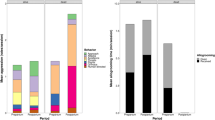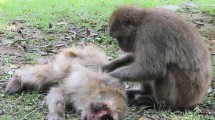Abstract
Among animals that form social bonds, the death of a conspecific may be a significant social event, representing the loss of an ally and resulting in disruptions to the dominance hierarchy. Despite this potential biological importance, we have only limited knowledge of animals’ reactions to the death of a group member. This is particularly true of responses to dead adults, as most reports describe the responses of mothers to dead infants. Here, we describe in detail and provide video evidence of the behavioral responses of a group of free-ranging rhesus macaques (Macaca mulatta) immediately after the death of a mid-ranking adult male as a result of a fatal attack. High-ranking male members of the group, suspected to have carried out the attack, dragged and bit the dead body, exhibiting a rate of aggression 20 times greater than baseline levels. Lower-ranking individuals approached and inspected the body by looking closely, smelling, and grooming the fur. There was inconclusive evidence that these rhesus macaques found the death of a conspecific stressful: Levels of grooming between group members after the fatal attack were significantly higher than baseline levels, and higher than levels of grooming after nonfatal attacks. However, when grooming levels were adjusted based on the assumption that individuals positioned close to the body, i.e., those visible to researchers, were more likely to be engaged in grooming than those positioned farther away, this difference from baseline was no longer significant. The rate of self-directed behaviors after the fatal attack was also not different from baseline. Many of the behaviors we observed directed toward the body (aggression, inspection) have been previously reported in chimpanzees and geladas, and are similar to reactions sometimes displayed by humans. As such, this report represents a potentially valuable contribution the nascent field of nonhuman primate thanatology.



Similar content being viewed by others
References
Anderson, J. R. (2011). A primatological perspective on death. American Journal of Primatology, 73, 410–414.
Anderson, J. R., Gillies, A., & Lock, L. C. (2010). Pan thanatology. Current Biology, 20, R349–R351.
Boccia, M. L., Reite, M., & Laudenslager, M. (1989). On the physiology of grooming in a pigtail macaque. Physiology and Behavior, 45, 667–670.
Byrne, R. W., & Bates, L. A. (2010). Primate social cognition: Uniquely primate, uniquely social, or just unique? Neuron, 65, 815–830.
Cronin, K. A., van Leeuwen, E. J. C., Mulenga, I. C., & Bodamer, M. D. (2011). Behavioral response of a chimpanzee mother toward her dead infant. American Journal of Primatology, 73, 415–421.
Douglas-Hamilton, I., Bhalla, S., Wittemyer, G., & Vollrath, F. (2006). Behavioural reactions of elephants towards a dying and deceased matriarch. Applied Animal Behaviour Science, 100, 87–102.
Drews, C. (1993). The concept and definition of dominance in animal behaviour. Behaviour, 125, 283–313.
Engh, A. L., Beehner, J. C., Bergman, T. J., Whitten, P. L., Hoffmeier, R. R., Seyfarth, R. M., et al. (2006). Behavioural and hormonal responses to predation in female chacma baboons (Papio hamadryas ursinus). Proceedings of the Royal Society of London B: Biological Sciences, 273, 707–712.
Fashing, P. J., Nguyen, N., Barry, T. S., Goodale, C. B., Burke, R. J., Jones, S. C. Z., et al. (2010). Death among geladas (Theropithecus gelada): A broader perspective on mummified infants and primate thanatology. American Journal of Primatology, 71, 1–5.
Gros-Louis, J., Perry, S., & Manson, J. H. (2003). Violent coalitionary attacks and intraspecific killing in wild white-faced capuchin monkeys (Cebus capucinus). Primates, 44, 341–346.
Hadidian, J., & Bernstein, I. S. (1979). Female reproductive cycles and birth data from an Old World monkey colony. Primates, 20, 429–442.
Hatfield, E., Cacioppo, J. T., & Rapson, R. L. (1994). Emotional contagion. Cambridge: Cambridge University Press.
Howard, D. F., & Tschinkel, W. R. (1976). Aspects of necrophoric behavior in red imported fire ant, Solenopsis invicta. Behaviour, 56, 157–180.
Irwin, M. R., Risch, S. C., Daniels, M., Bloom, E., & Weiner, H. (1987). Plasma-cortisol and immune function in bereavement. Psychosomatic Medicine, 49, 210–211.
Martin, P., & Bateson, P. (1993). Measuring behaviour: An introductory guide (2nd ed.). Cambridge: Cambridge University Press.
McComb, K., Baker, L., & Moss, C. (2006). African elephants show high levels of interest in the skulls and ivory of their own species. Biology Letters, 2, 26–28.
Rawlings, R. G., & Kessler, M. J. (1986). The Cayo Santiago macaques: History, behavior & biology. Albany: State University of New York Press.
Schino, G., Perretta, G., Taglioni, A. M., Monaco, V., & Troisi, A. (1996). Primate displacement activities as an ethopharmacological model of anxiety. Anxiety, 2, 186–191.
Semple, S., Higham, J. P., MacLarnon, A., Ross, C., & Lehmann, J. (2010). Comment on ‘Pan Thanatology’. Current Biology, http://www.cell.com/currentbiology/comments/S0960-9822(10)00145-4.
Shutt, K., MacLarnon, A., Heistermann, M., & Semple, S. (2007). Grooming in Barbary macaques: Better to give than receive? Biology Letters, 3, 231–233.
Stewart, F. A., Piel, A. K., & O’Malley, R. C. (2012). Responses of chimpanzees to a recently dead community member at Gombe National Park, Tanzania. American Journal of Primatology, 74, 1–7.
Teleki, G. (1973). Group response to the accidental death of a chimpanzee in Gombe National Park, Tanzania. Folia Primatologica, 20, 81–94.
Valero, A., Schaffner, C. M., Vick, L. G., Aureli, F., & Ramos-Fernandez, G. (2006). Intragroup lethal aggression in wild spider monkeys. American Journal of Primatology, 68, 732–737.
Visscher, P. K. (1983). The honey bee way of death: necrophoric behavior in Apis mellifera colonies. Animal Behaviour, 31, 1070–1076.
Acknowledgments
We thank veterinary pathologist Andres Mejia for performing the necropsy, as well as Nahiri Rivera and the Caribbean Primate Research Center (CPRC) staff. We also thank Jo Setchell and an anonymous reviewer for their help in improving the manuscript. The authors are supported by NIMH grant R01-MH089484. The CPRC is supported by grant 8-P40 OD012217-25 from the National Center for Research Resources (NCRR) and the Office of Research Infrastructure Programs (ORIP) of the National Institutes of Health.
Author information
Authors and Affiliations
Corresponding author
Additional information
Jacqueline S. Buhl and Bonn Aure contributed equally and wish to be considered joint first authors.
Electronic Supplementary Material
Below is the link to the electronic supplementary material.
Responses by rhesus macaques to the body of a dead adult male member of their group. High-ranking individuals are seen directing aggression toward the body, while lower-ranking individuals are seen approaching, looking at, and grooming the body. Many group members are seen grooming one another, which may be a potential indicator of elevated stress levels. (MPG 53990 kb)
Rights and permissions
About this article
Cite this article
Buhl, J.S., Aure, B., Ruiz-Lambides, A. et al. Response of Rhesus Macaques (Macaca mulatta) to the Body of a Group Member That Died from a Fatal Attack. Int J Primatol 33, 860–871 (2012). https://doi.org/10.1007/s10764-012-9624-1
Received:
Accepted:
Published:
Issue Date:
DOI: https://doi.org/10.1007/s10764-012-9624-1




